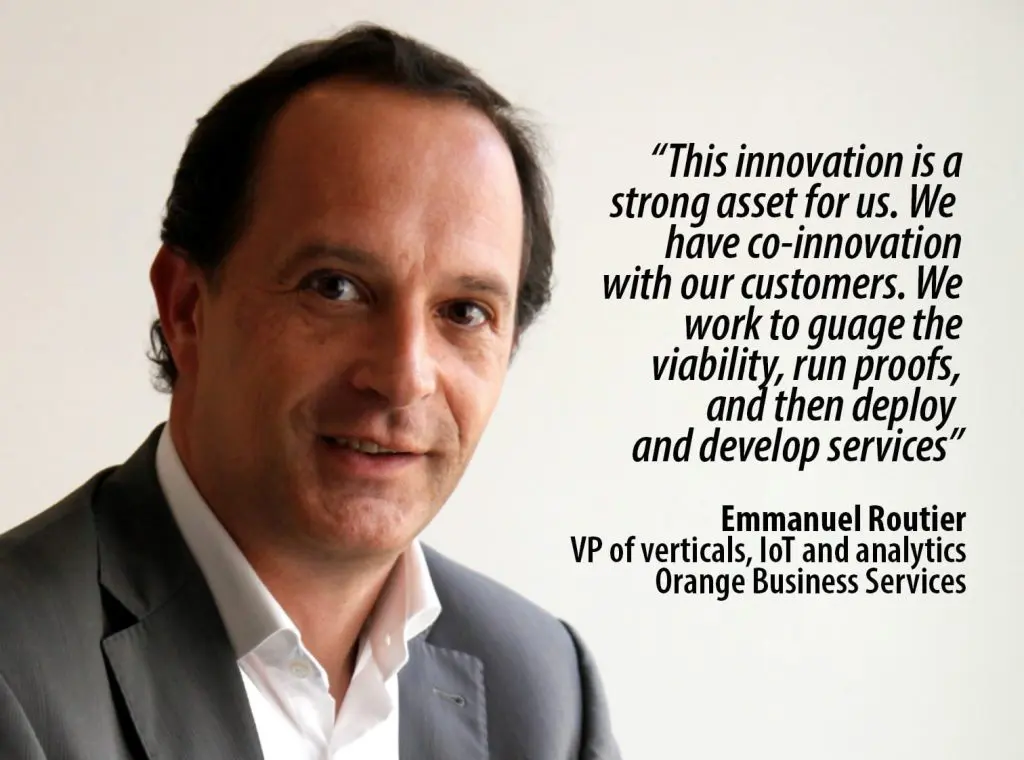Having effectvely reduced the discipline of network operations to an elaborate marketing exercise, to sell look-alike SIM cards and airtime bundles, it seems the new 5G era has telecoms operators sounding different, again. It seems like their personalities are coming through, at last.
This trend was apparent at MWC 2019 last month. In the orange corner… well, Orange, or rather Orange Business Services, the French carrier’s enterprise division, which is curating a more advanced (and interesting) digital-comms solution than its parent’s straight consumer offer.
Orange’s ‘personality’ appears to be projected through OBS, which has settled on four development paths: in cyber security, cloud services, data analytics, and the internet of things (IoT). Orange Business Services provides a home for its Orange Labs innovations in these fields, as well.
And innovation goes to the heart of it for Orange. The stand-guy at MWC, accosted en route to a briefing, explained Orange Labs, jockeying like a startup for innovation, is able to play outside of the confines of the traditional telecoms space, as it is mapped by the industry collective in 3GPP.
It means Orange Labs has a highly-standardised springboard for its adventures in data and analytics, artificial intelligence (AI), and cloud and edge computing. In the briefing itself, Emmanuel Routier, the company’s vice president of verticals, IoT and analytics, presents an idea of “co-innovation”.
He comments: “This innovation is a strong asset for us. We have co-innovation frameworks with our customers. We work to guage the viability, run proofs-of-concept, and then deploy and develop services.”
He adds: “We have flexibility, strong R&D, and money to put into it – to pave the the way towards digital transformation for our customers.”
It is a snapshot, perhaps, a glancing impression, of Orange as a champion of grass-roots innovation. But the sense the sands are shifting , and traditional operators have a rare chance to reinvent themselves, is strong.
The first incarnation of 5G, as enhanced mobile broadband (eMBB), set out in Release 16, will bring evolution, the story goes; the second and third, defining massive machine-type (mMTC) and ultra-reliable low-latency (URLLC) communications, will bring revolution, proper – as per the dogma of industrial transformation.

In the meantime, political and regulatory impulses are liberating spectrum for industry, to drive digital transformation and economic growth. Even 3GPP has moved to make LTE workable in the ulicensed 5 GHz and 6 GHz bands, as part of Release 16.
The sub-text is the old telecoms providers will not be the only network operators in the new digital era, and they are required to define their offer to enterprises, and their characters alongside, in order to capture new ‘verticals’. What does Routier think? Is Orange different, again?
“Yes. We are different from anyone else. We are a carrier-grade system integrator,” he says. But the terminology is not new, at least among telecoms operators. AT&T uses exactly the same in the US. But Routier goes on: “When we do innovation as a system integrator, we bring our R&D people, who are telco people. That makes us different.”
Is the innovation, then, what sets Orange apart? “We take the innovation to our customers, and we take our customers to the innovation,” he responds. “That’s the proof point.”
It’s a bit woolly, perhaps, but it gets us back to this idea of technological co-innovation, sprung by a carrier-grade cellular network, and attended by a various complementary communications tools.
Orange Business Services is driving digital-change in collaborauon with its customers, says Routier. “We accompany customers on their digital journey.”
The final destination is a place of reinvention, he says. He gives the example of a connected boiler, making possible any number of as-a-service constructs. Orange has a deal with ELM Leblanc, a France-based boiler company owned by German firm Bosch, to enable predictive maintance on its assets in the field.
This road of change is just starting. The future is not written; a boiler maker could eventually charge for hot water, at the right time, in the right quantity. “Can you imagine?”
But it’s about the journey, rather than the destination, in practical terms anyway. “Frankly, customers are just focused on improving their processes. Management buy-in is required to make these more fundamental changes,” he explains.
In the meantime, its co-innovation effort is geared towards setting the groundwork, he says – to maximise systems and processes before customers embark on grander schemes. The cliche holds: Orange has its roots in networking, and Orange Business Services starts with a ‘toolbox’ of connectivity protocols.
It will pick the right one, according to the use case and the business case, whether it is fibre, LTE, or LTE-M, LoRaWAN or Bluetooth Low Energy (BLE). “But while we are selling the network, we’re not just selling the network,” he adds.
Instead, it is supplying a connected solution, he explains, covering “all the different components”, from “devices, machines, and controllers” through to the “transport”, and on to the storage, manipulation, and application of data on top.
Orange has its own IoT management platform, Live Objects, to oversee devices and data. Live Objects, making use of in-the-cloud and on-premise data storage and analytics, is part of its default off-the-shelf IoT offer for enterprises, available under the Orange brand.
It works this trio of management tools, for connectivity, devices, and data, into a pre-packaged IoT solution. “You know, 80 per cent of this stuff is reusable,” comments Routier.
“We have the ‘things’, we have the connectivity, we have the platform – that is a basic service, which is Orange-branded, end-to-end… We believe in all those components, and we still have some to address. But certain verticals are more developed, and very interested.”
In particular, Orange’s own-branded IoT solution is finding traction as a plug-and-play management suite for smart city applications and indoor and outdoor tracking. “The smart city domain is very mature for us,” notes Routier.
It appeals to large towns and mid-sized cities, he says, which want scalable, easily-costed, plug-and-play solutions. “The others want customised solutions,” he says. “It’s about monitoring air quality, reservoir levels, temperatures, and bin levels.”
Beyond, Orange Business Services has a network of partners to call upon for more advanced IoT solutions, enabling capabilities like predictive maintenance. “Sometimes there are specific needs, where then you need partners.”
In terms of partners, Routier makes passing mention of Ubisense (“the best-in-class indoor tracking solution”), Microsoft Azure (“for deep analytics, specific elements”), and Siemens MindSphere(“related to Siemens controllers”).
“That’s how we would position the different elements,” he says, in reference to its twin strategies, to offer Orange-branded starter packs or more advanced and bespoke offers with partners.
This article continues here. Sign up to the newsletter to get all the latest updates from Enterprise IoT Insights.
Orange on IoT: “We’re different; we take innovation to the customer”
Orange on LPWA: “If there’s no improvement in the radio, we’ll keep the same system”
Orange on URLLC (and private 5G): “The economics favour public networks”

